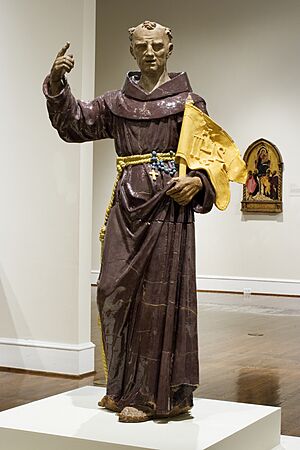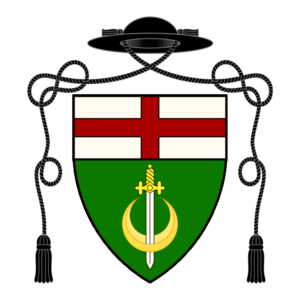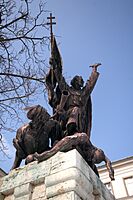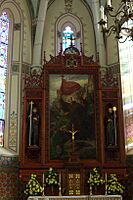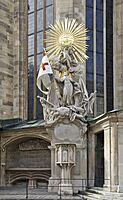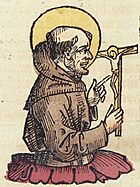John of Capistrano facts for kids
Quick facts for kids SaintJohn of Capistrano O.F.M. |
|
|---|---|

Illumination depicting St. John of Capistrano
(c. 1470) |
|
| Confessor | |
| Born | 24 June 1386 Capestrano, Abruzzi, Kingdom of Naples |
| Died | 23 October 1456 (aged 70) Ilok, Syrmia, Kingdom of Hungary |
| Venerated in | Roman Catholic Church |
| Canonized | 16 October 1690 (Liturgy); 4 June 1724 (Bull), Rome by Pope Alexander VIII and Pope Benedict XIII respectively |
| Feast | 23 October; 28 March (General Roman Calendar, 1890–1969) |
| Patronage | Jurists, Belgrade and Hungary |
John of Capistrano (born June 24, 1386 – died October 23, 1456) was a Franciscan friar and Catholic priest. He came from the town of Capestrano in Italy. He was known for being a powerful preacher, a religious scholar, and an inquisitor.
He earned the nickname "the Soldier Saint" because of his actions in 1456. At 70 years old, he helped lead a Crusade against the Ottoman Empire. This happened during the siege of Belgrade. He worked with the Hungarian military leader John Hunyadi.
After his death, John of Capistrano became a saint. He is the patron saint of jurists (people who study law) and military chaplains. Two Franciscan missions in the United States are named after him. One is Mission San Juan Capistrano in California. The other is Mission San Juan Capistrano in Texas.
Contents
Early Life and Education
John was born in the village of Capestrano in the Kingdom of Naples. This area is now part of Italy. His father had moved to Italy with the royal court of Louis I of Anjou.
John studied law at the University of Perugia. In 1412, King Ladislaus of Naples made him Governor of Perugia. This was a difficult job because Perugia was a troubled city. John's task was to bring order to the area.
In 1416, a war started between Perugia and the House of Malatesta. John was sent to make peace. However, the Malatestas put him in prison. While in prison, he began to study theology, which is the study of religious faith. After he was released, he decided to become a Franciscan friar. He said this decision came from a dream where Saint Francis of Assisi told him to join the Order.
Becoming a Friar and Preacher
On October 4, 1416, John joined the Order of Friars Minor in Perugia. He joined with James of the Marches. They both studied theology under Bernardine of Siena in Fiesole, near Florence.
John quickly became very strict in his religious practices. He strongly supported the idea of following the Franciscan rules very carefully. He followed Bernardine's example. From 1420 onwards, he became a very effective preacher in many cities. He was ordained as a priest in 1425.
John was different from many Italian preachers of his time. He was very successful in northern and central Europe. He preached in places like Germany, Bohemia, Austria, Hungary, Croatia, and Poland. Churches were often too small to hold the crowds. So, he would preach in public squares. In Brescia, Italy, he once preached to a crowd of 126,000 people.
A Reformer and Diplomat
When John was not preaching, he wrote many papers against different kinds of heresy. Heresy means beliefs that go against official religious teachings. His early biographers wrote a lot about this part of his life.
He also helped Bernardine of Siena reform the Franciscan Order. They wanted to make the Franciscan communities follow stricter rules. Like Bernardine, John strongly promoted devotion to the Holy Name of Jesus. Because of this, both John and Bernardine were accused of heresy. In 1429, they had to go to Rome to answer these charges. John was chosen to speak for them. Both were found innocent by the church leaders.
Popes Eugene IV and Nicholas V often sent John on important missions. In 1439, he was sent to Milan and Burgundy. His job was to oppose the claims of Antipope Felix V. In 1446, he went on a mission to the King of France. In 1451, he became an Apostolic Nuncio (a papal ambassador) to Austria. During this time, John visited many parts of the Holy Roman Empire.
As an ambassador or inquisitor, he worked against various groups. These included the last Fraticelli in Ferrara and the Jesuati in Venice. He also worked against Crypto-Jews in Sicily, Moldavia, and Poland. Most importantly, he went after the Hussites in Germany, Hungary, and Bohemia. He wanted to stop any talks between Rome and the Bohemian "Hussite king" George of Podiebrad. He believed that trying to find common ground with them meant supporting heresy.
John also worked to reform the Order of Friars Minor. He believed that the Pope had the highest authority in the church. He wrote and preached about this idea. John, Bernardine, James of the Marche, and Albert Berdini of Sarteano are seen as the four main leaders of the Franciscan reform movement.
Preaching Against Different Beliefs
John's work included preaching against groups whose beliefs were different from the Catholic Church. He saw it as an act of love to preach against those who did not accept Jesus as the Messiah. Between 1451 and 1453, his strong sermons led to the expulsion of Jewish communities from many southern German regions. People at the time did not criticize his actions as uncharitable.
The Soldier Priest in Battle
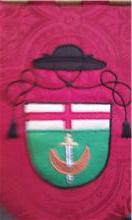
After the fall of Constantinople in 1453, the Ottoman Empire became a threat to Christian Europe. Sultan Mehmed II led the Ottomans. In 1454, Pope Callixtus III sent John, who was 70 years old, to preach a Crusade. He spoke at the Imperial Diet (a meeting of leaders) in Frankfurt.
He did not get much support in Bavaria and Austria. So, he focused his efforts in Hungary. By July 1456, John had gathered a large force. It was made up of peasants and local landowners. They were not well-trained but were very motivated. John and John Hunyadi traveled together. They commanded their armies separately. Together, they had about 40,000 to 50,000 troops.
Hunyadi managed to break the Ottoman naval blockade on the Danube River. This allowed him to bring supplies and more soldiers into the city. Some reports say that the peasant soldiers started fighting on their own. This forced John and Hunyadi to join the battle. Hunyadi had told his soldiers not to try to steal from the Ottoman camps. But some units left the city walls and started attacking enemy soldiers. More defenders joined them, and a small incident quickly became a full battle.
John of Capistrano first tried to order his men back inside the walls. But soon, he found himself surrounded by about 2,000 peasant soldiers. He then led them towards the Ottoman rear across the Sava river. At the same time, Hunyadi led a desperate charge from the fort. He aimed to capture the Ottoman cannon positions. After a fierce battle, the Ottomans retreated under the cover of darkness. The siege was lifted.
Because of his involvement, John was called "the Soldier Priest." Although he survived the battle, John became sick with the bubonic plague. This disease was common in armies at that time due to poor hygiene. He died on October 23, 1456. He passed away in the nearby town of Ilok, which is now in Croatia.
Sainthood and Feast Day
John of Capistrano was made a saint on October 16, 1690, by Pope Alexander VIII. The official document, called a Bull of Canonization, was published on June 4, 1724, by Pope Benedict XIII.
In 1890, his feast day was added to the General Roman Calendar. It was set for March 28. In 1969, Pope Paul VI moved his feast day to October 23. This is the day he died. If Mass is said using the 1962 Roman Missal, his feast day remains on March 28.
-
Statue of John of Capistrano in Budapest, Hungary
Missions Named After Him
John of Capistrano was a Franciscan reformer who preached simplicity. Because of this, two Spanish missions were named after him. These missions were founded by Franciscan friars in what was then Spanish America. One is Mission San Juan Capistrano in California. The other is Mission San Juan Capistrano near San Antonio, Texas.
Patron Saint
Saint John of Capistrano is the patron saint of military chaplains and jurists.
See also
 In Spanish: Juan de Capistrano para niños
In Spanish: Juan de Capistrano para niños


